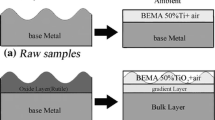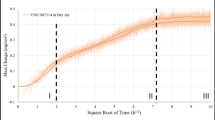Abstract
The effect of a surface deposit of NaCl on the oxidation characteristics of a high-temperature titanium alloy was studied in the temperature range of 400–600°C. The influence of the water vapor content in the oxidizing environment was examined in the light of an existing electrochemical mechanism proposed for the hot-salt stress-corrosion-cracking phenomenon found in titanium alloys. It was established that the NaCl deposit increased the oxidation rate by a factor of 100 for hygrometry levels of 10 ppm or higher. Further, there exists a hygrometry threshold between 10 and 5×10−3 ppm below which the NaCl-induced accelerated oxidation decreases with decreasing hygrometry level. Electron microprobe analysis suggests that the titanium matrix reacts with chlorine before forming rutile.
Similar content being viewed by others
References
V. C. Petersen,J. Met. 40 (Apr. 1971).
R. Garfinkle,Met. Trans. 4, 1477 (1973).
P. Kofstad,High Temperature Oxidation of Metals (John Wiley & Sons; New York, 1966), p. 170.
Author information
Authors and Affiliations
Additional information
The authors are indebted to the Société Nationale d'Etudes et de Construction de Moteurs d'Aviation (S.N.E.C.M.A.) for its financial support of this study.
Rights and permissions
About this article
Cite this article
Dumas, P., John, C.S. NaCl-induced accelerated oxidation of a titanium alloy. Oxid Met 10, 127–134 (1976). https://doi.org/10.1007/BF00614242
Received:
Issue Date:
DOI: https://doi.org/10.1007/BF00614242




